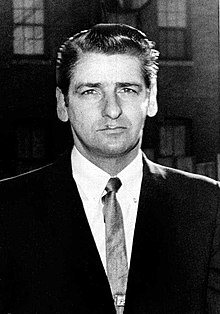Albert DeSalvo | |
|---|---|
 DeSalvo after escaping Bridgewater State Hospital and being caught in Lynn, Massachusetts, in 1967 | |
| Born | Albert Henry DeSalvo September 3, 1931 Chelsea, Massachusetts, U.S. |
| Died | November 25, 1973 (aged 42) Walpole, Massachusetts, U.S. |
| Cause of death | Stabbing |
| Other names |
|
| Criminal penalty | Life imprisonment |
| Details | |
| Victims | 1 (confirmed), 12 more (suspected) |
Span of crimes | June 14, 1962 – January 4, 1964 |
| Country | United States |
| State(s) | Massachusetts |
Date apprehended | October 27, 1964 |
Albert Henry DeSalvo (September 3, 1931 – November 25, 1973) was an American murderer and rapist who was active in Boston, Massachusetts, in the early 1960s. He is known to have confessed to being the "Boston Strangler", a serial killer who murdered thirteen women in the Boston area between 1962 and 1964. Lack of physical evidence supported his confession, and he was only prosecuted in 1967 for a series of unrelated rapes, for which he was convicted and imprisoned until his death in 1973. His confessing to having murdered multiple women was disputed, and debates continued regarding which crimes he truly had committed.
By the early 21st century, techniques for DNA capture and analysis could allow for the re-investigation of some criminal cases. In July 2013, an analysis of semen found around the body of Mary Sullivan, who was raped and murdered and is the last of the Strangler's victims, was matched to DNA obtained from DeSalvo's nephew. Because men who are descended from a common male ancestor carry the same y-DNA, investigators believed that this finding linked DeSalvo to the murder of Sullivan. The DNA match excluded 99.9% of the remaining population.[1] Later that month authorities exhumed DeSalvo's corpse and found that his DNA was a match.[2][3]
- ^ Bidgood, Jess (July 11, 2013). "50 Years Later, a Break in a Boston Strangler Case". The New York Times. New York City. Retrieved October 16, 2013.
- ^ "Remains unearthed of confessed Boston Strangler". USA Today. Mclean, Virginia: Gannett Company. Associated Press. July 12, 2013. Retrieved October 13, 2013.
- ^ Cite error: The named reference
NYDNwas invoked but never defined (see the help page).